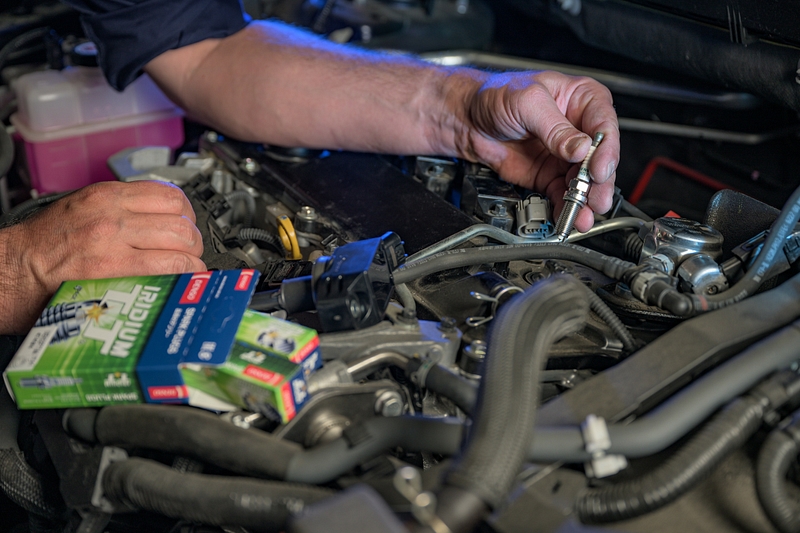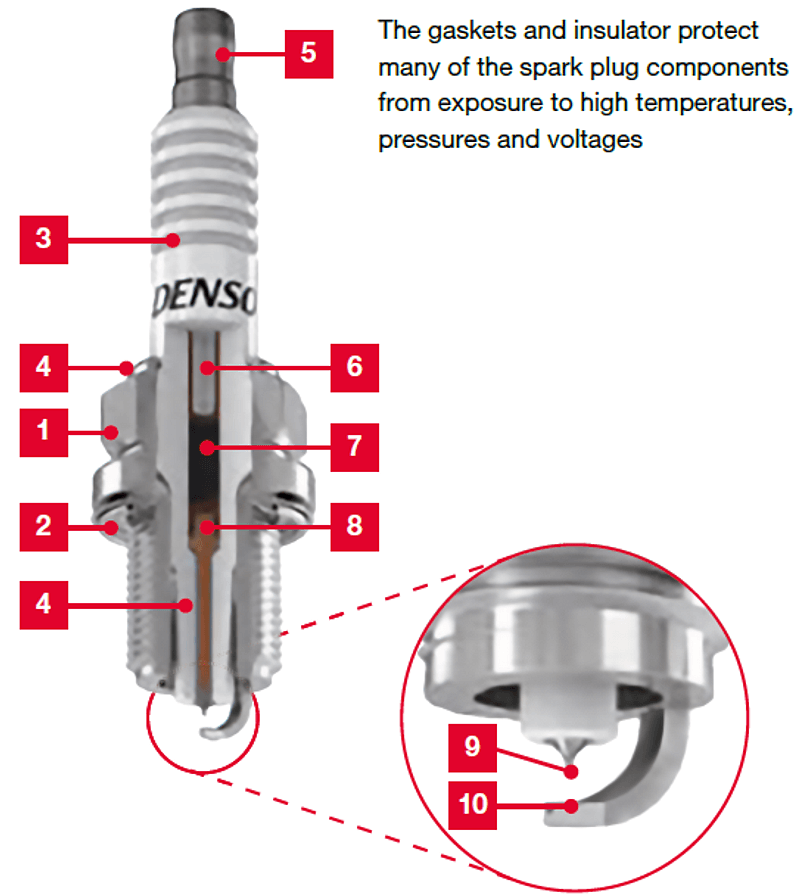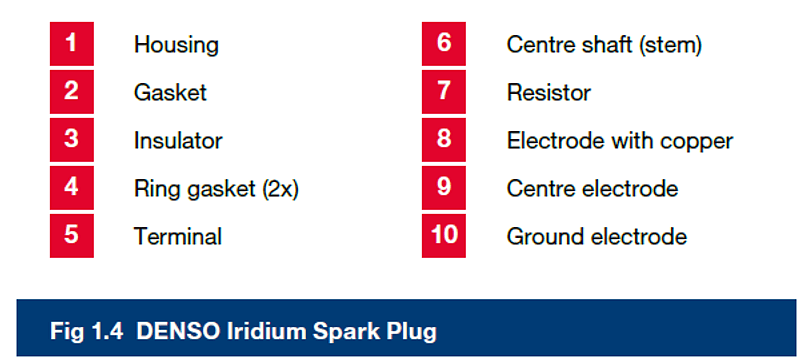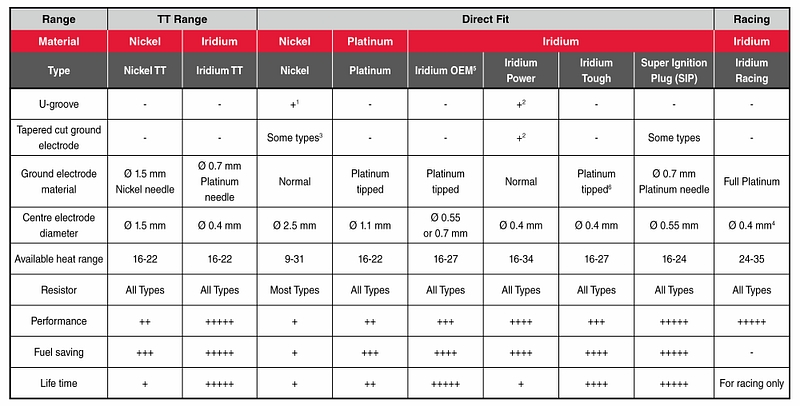What does a spark plug do and how does it work

In common with diesel engines, petrol fuelled engines rely on the combustion of a mixture of fuel and air within their cylinders to keep the engine running, which is why they are collectively known as internal combustion engines. However, unlike a diesel, where combustion can happen spontaneously under the fuel/air mixture’s compression, a petrol fuelled engine requires a spark to ignite the mixture, and that is achieved through the use of spark plugs.
When the spark occurs, it is precisely controlled by the engine’s management system, but at exactly the right time, the ignition system delivers a short burst of high voltage energy to the spark plug, which creates a spark that travels across a small gap from the central electrode, to the ground electrode at the tip of the spark plug, which is screwed into the top of the engine’s cylinder. At the centre of this spark the temperature can briefly reach or even exceed 10,000°C, which provides sufficient heat to ignite the mixture in the cylinder.
The combustion process is therefore one of the most important parts of the whole engine operating cycle and if combustion is not efficient the engine will not produce the required power. Additionally, inefficient combustion will create high levels of pollutants and result in excessive fuel consumption.
It is the heat produced by the combustion process that causes the compressed gases in the cylinder to expand and push the piston down the cylinder, but it is the spark plug that is needed to create the initial high temperature spark that starts the whole combustion process and the spark plug must be able to continue to provide a spark for many thousands of kilometres and many millions of combustion cycles.
So, although the purpose of the spark plug is to ensure the fuel/air mixture is ignited consistently and efficiently, its primary task is to make use of high voltage energy to produce a very rapid and intensely hot spark. The voltages are typically in the range of 10,000 to 40,000 volts (10kV to 40kV), but the increasing trend is towards voltages of 45kV and higher. The spark plug construction must therefore include good insulation between the different spark plug components to ensure that the high voltage does not escape or short out to other components.
The compression and combustion cycle also produces very high pressures, which means there must be an effective seal between the spark plug casing and the engine. However, the construction of the spark plug must also include internal sealing to prevent hot and high pressure gases passing between the different spark plug components, because, apart from loss of pressure, if any gases are able to pass through the spark plug assembly, they would damage the spark plug components.
The important features of spark plug design are therefore the ability to withstand high temperatures and temperature changes, along with the ability to withstand high pressures; but at the same time the spark plug must operate with high voltages to produce a hot spark every few thousandths of a second for the whole of the spark plug’s service life.
To prevent the damaging effects of high temperatures, the spark plug must be able to dissipate or transfer heat away from the spark plug and through the engine casing. But importantly, if too much heat is passed away or dissipated from the spark plug, this can then reduce the temperature of the spark and cause poor ignition and combustion. Additionally, if too much heat is dissipated, the spark plug might not be able to burn off the contaminants.


Spark plug construction
To be able to work effectively and efficiently under these difficult operating conditions and to achieve the correct performance requirements, spark plugs are constructed in three main sections: the housing, insulator and electrodes, and these sections then contain individual components that are made from carefully selected materials.
The example above shows the construction of a DENSO Iridium Power Spark Plug.
The housing (item 1) forms an outer shell that surrounds and supports the insulator and secures the spark plug assembly to the engine. The ring washer or gasket (item 2) provides an insulating seal between the spark plug housing and engine to prevent any gases escaping during compression and combustion. The ground electrode (item 10) is mounted to the threaded lower section of the housing, which allows electric current to flow through the engine back to the battery.
The ceramic-based insulator (item 3) provides electrical insulation between the terminal, centre shaft, housing and centre electrode. With spark voltages on some modern ignition systems exceeding 40kV, the insulator, with a thickness of only millimetres, must provide the required insulating properties. As a result, DENSO spark plugs incorporate a ceramic material with high purity aluminium oxide to provide superior heat resistant characteristics, mechanical strength and excellent electrical insulation. The two ring gaskets (item 4) provide a secure fit and airtight seal between the housing and the insulator.
The high voltage is supplied through the terminal (item 5), either from a direct fit to the base of the ignition coil or by using a spark plug wire/cable that connects the plug terminal to the coil.
The steel centre shaft (item 6) connects the terminal and the centre electrode and allows high voltage current to flow from the terminal to the centre. The resistor (item 7), which is also referred to as a suppressor, reduces the peak current of the spark. Without a resistor, the peak current will create bursts of electromagnetic fields or radio noise, which can interfere with electrical equipment in the car.
The centre electrode (item 9) is made from materials, such as nickel alloys, that can resist high temperatures. These materials must also be extremely hard and durable to minimise the wear caused by spark erosion. The centre section of the electrode (item 8) often contains a copper core to improve thermal conductivity.
For improved performance and durability, centre electrodes can also be manufactured with an electrode tip made from precious metals that are even tougher than the traditional electrode materials. These harder wearing materials can operate at higher temperatures with reduced wear, but another major benefit is that they allow for the use of finer electrodes, resulting in better ignition performance. These smaller electrodes lower the required voltage, ensure a reliable spark and reduce the quenching effect, so improving ignition performance.
The ground electrode (item 10) is subject to the extreme temperature changes inside the combustion chamber and although a nickel chrome alloy is used for most of these electrodes, platinum can be added to extend their life. Some spark plugs however, are equipped with a copper core ground electrode for improved thermal conductivity. As with the centre electrode, the smaller needle type ground electrodes lower the required voltage, ensuring a reliable spark, which reduces the quenching effect and improves ignition performance.
You can find more details about Spark Plug technology in the DENSO Spark Plug Manual.
Do they need replacing?
Irrespective of the quality of the spark plug, because it operates in a very hostile high temperature/high pressure environment, over time its efficiency will reduce and it will have to be replaced, which is why vehicle manufacturers include spark plug replacement on their scheduled service intervals.
The DENSO spark plug range

How to find the right spark plug?
Although there are many factors to consider, such as their dimensions, projection and heat range, the easiest way to find the correct DENSO option based on make and model information or cross references is via the DENSO e-catalogue.
Further details of the DENSO Spark Plugs are available online in DENSO products area and Download area.




















































